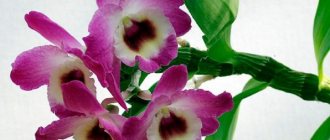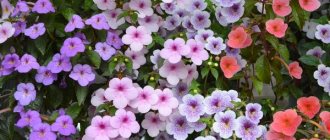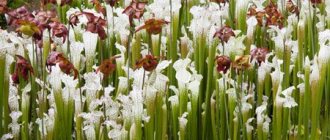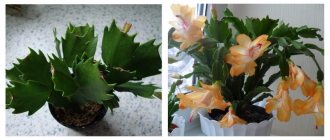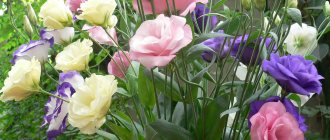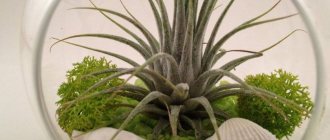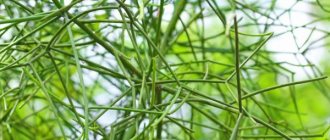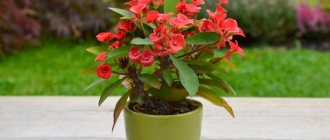Araucaria is a very pretty evergreen coniferous plant that prefers a humid and warm climate.
In nature, its height reaches 60 meters, and at home, with good care and favorable conditions, indoor araucaria grows up to two. Perfectly moisturizes and refreshes the air. It is indispensable for people suffering from asthma or other chronic lung diseases, since pine needles have the ability to cleanse the room of pathogenic microorganisms and release beneficial aromatic substances.
Types and varieties with photos
There are 19 species of Araucaria ; below are descriptions and photos of the main varieties that can be cared for at home.
Variegated
A species of Araucaria, also called "Norfolk spruce". In nature they grow to gigantic sizes - 70m. and higher. At home, it can reach the ceiling - up to 3 meters.
Room
It grows well in a city apartment if you provide the plant with sufficient watering and the right temperature - cool in winter, hot in summer.
Indoor araucaria grows slowly, but with proper care and regular replanting into a larger pot, it grows up to 2 meters.
Heterophyll
In nature, Heterophyll grows in New Guinea and Australia and does not require special care. At home, it grows to a maximum of one and a half meters, that is, among all species it is the shortest. It is most similar to a Christmas tree - the branches of Araucaria are light, delicate green, and form a pyramid.
Araucaria species
Narrow-leaved araucaria (Araucaria angustifolia) , or Brazilian araucaria (Araucaria brasiliana). Grows in the mountains of Southern Brazil. These are large trees, reaching 50 m in height in nature. The branches of this plant are thin and drooping. The leaves are linear-lanceolate, up to 5 cm long, bright green. Suitable for growing indoors, since araucaria rarely grows more than three meters in indoor and greenhouse conditions.
Forests of Brazilian araucaria are called pinheiros in Brazil (the Portuguese word is all from the same Latin root “pin” - pine), they occupy a significant part of the state of Paraná (the wood of this araucaria is called “Paran pine”). Here, araucaria forests are adjacent (vertically) to tropical rain forests and themselves contain some typical species of these forests in the undergrowth. However, the araucaria forests themselves in Brazil cannot be considered climatically tropical. In large areas of light (rare) araucaria forest, its undergrowth consists of continuous thickets of Paraguayan tea, or mate (Ilex paraguariensis). Araucaria brasiliensis is the most important timber tree in Brazil. Its wood is widely used by local industry as a building material, as well as for the manufacture of furniture and all kinds of crafts, and even as raw material for paper. It is used in the production of musical instruments.
Araucaria heterophylla or indoor spruce (Araucaria heterophylla). The island's homeland is Norfolk. These beautiful majestic trees with a pyramidal crown reach up to 60 m in height, with brownish flaky bark. The branches are arranged whorled, extending horizontally at right angles to the trunk, forming a generally pyramidal crown. The leaves are soft, awl-shaped, slightly curved upward, tetrahedral, small, up to 2 cm long, needle-shaped, light green, arranged densely in a spiral. In culture, it is often confused with another species of Araucaria high (A. excelsa).
Columnar araucaria or Cook's araucaria (Araucaria columnaris) , distributed in the southern tropical zone in the New Hebrides and on the Pine Island (New Caledonia). The trunks of these majestic trees are uniformly covered, from the very base to the top, by a narrow crown, vaguely reminiscent of the crown of a pyramidal cypress. It is formed by relatively short branches, collected in whorls and extending from the trunk almost at a right angle (in cypress the branches are pressed to the trunk). On Sosnovy Island, columnar araucaria forms dense coastal stands of trees that amazed the first travelers with their appearance, who compared them either to basalt columns or to smoking factory chimneys. At the very top of the tree, the crown is usually somewhat expanded. Columnar cones of Araucaria, up to 10 cm long, have a bristly appearance due to the tops of the scales, drawn into a long (5-6 mm) awl-shaped appendage, which is bent downwards. In many ways, columnar Araucaria is similar to variegated Araucaria. It also undergoes a change in leaf shape during the transition from a juvenile to an adult state. But you can also notice differences in the leaves, which at first glance are very similar: columnar araucaria leaves are softer, more straightened, with a gradually narrowed apex (variegated araucaria - suddenly narrowed) columnar araucaria is widespread in culture, but only in countries with tropical, less often subtropical climate (in Australia, Indonesia, Africa, even Italy). It can also be seen in greenhouses.
Chilean araucaria (Araucaria araucana) grows not only in Chile, but also in western Argentina. Araucaria Chilean is a very large tree, reaching a height of 60 m with a trunk diameter of up to 1.5 m. The crown of young trees is broadly pyramidal, with its lower branches lying directly on the ground. With age, the lower branches usually fall off. The lateral branches of mature trees are located 6-7 in whorls, they are horizontally spread or slightly hanging in old trees; the crown becomes flat-umbrella-shaped, located only at the very top of the trunk. The bark is resinous, thick, longitudinally fissured. The leaves of Araucaria Chilean are hard, prickly, dark green, spirally arranged, covering the branches very tightly to each other. Chilean Araucaria is light-loving, grows in humid climates, on evenly moist, but not swampy, soils sufficiently rich in nutrients. It tolerates dry conditions well, as well as light frosts. The large seeds of Chilean Araucaria are nutritious and tasty. Araucanas eat them raw or roasted. The wood of this araucaria is yellowish-white in color and is used in construction. Araucaria Chilean is a very valuable ornamental plant. In 1796, the rut was already introduced into England (the first grown tree existed for almost a hundred years). Later, this araucaria spread widely in Western Europe (up to Norway), and in Russia - only in the botanical gardens of the Crimea and the Caucasus.
Plant care
Where does it grow?
The plant is not very demanding, but for those who want to get a healthy tree with a beautiful, uniform color, several conditions must be met.
Araucaria grows well in a humid, warm, but not hot room.
It is advisable to take the flower pot out into the air as often as possible in summer and spring - for example, put it on a windowsill with an open window or take it to the country house. In winter, it is recommended to ventilate the room at least 5 times a day.
You cannot place a pot with a plant near a radiator or fireplace in the country - too dry and hot air will either destroy the flower or make it weak and inconspicuous in appearance.
Soil and fertilizers
Araucaria grows well in slightly acidic, well-loosened soil. Drainage is required - special purchased or large stones treated with ash.
Stores sell ready-made mixtures for Christmas trees. If it is not there, you can prepare the soil yourself by mixing peat, leaf humus, and coarse sand in equal parts. Place some turf soil on top of the pot.
From March to the end of November, Araucaria needs to be fed every 15 days - with special complex and organic fertilizers.
Humidity and watering
To form a bright, fluffy crown and to keep the needles green, the room must be humid - you need to use an air washer or a household humidifier all year round.
- From time to time, the branches should be sprayed with settled or filtered water. If possible, this should be done a couple of times a day, in winter - more often.
- You cannot use cold, hard water for watering - the araucaria will wither. Filtered, room temperature or slightly warmer water is ideal for watering araucaria.
- The plant is moisture-loving and does not tolerate drying out of the soil, so in summer watering is done almost every day, in winter - twice a week.
Drying out the soil even for a short time can lead to death.
Lighting and location of the pot
The brighter the room, the brighter and more beautiful the crown of your home Christmas tree will be. For its even formation, the pot with araucaria must be turned towards the sun - either several times a day, or once a week - depending on the season. Araucaria does not tolerate bright sun - the needles may turn brown and fall off, so when placing a flower pot on a windowsill, it is advisable to shade the glass with translucent curtains or sheets of paper - for example, for baking.
Temperature
In summer, the temperature in the room should not rise above 23 degrees for a long time; in winter, it is preferable to be about 15.
If araucaria grows in a city apartment, where it is warmer in winter than in summer, you need to open the windows as often as possible and reduce the air temperature in the room.
For the winter, the plant can be moved to the coolest and darkest place in the apartment - for example, a corridor or a bathroom.
In a hot room, araucaria will also grow, but its crown will turn yellowish and the needles will fall off.
Bloom
The plant itself does not bloom the way we used to imagine. In the wild, large, mature trees “bloom” with small cones, but domestic plants are not covered with either cones or “catkins” even with the most careful care and ideal conditions.
Pruning and crown formation
The top of the Christmas tree cannot be touched - if it is damaged, Araucaria withers and may die. To make the plant more decorative, regularly - once every few months - you need to trim the lower branches.
If you don’t do this, the needles on them turn yellow, fall off and the plant looks untidy.
Rest period
In winter, the growth of the Christmas tree stops, some of the needles from the lower branches turn yellow and fall off.
During this period, you need to provide the plant with cool (about 15-16 degrees) air, no bright sun and reduce the frequency of watering by half.
Spraying is carried out in the same way as in summer - even at rest, araucaria needs humidified air.
Plants are fertilized once during the winter - ideally at the end of December.
Useful video
From the video you will learn how to properly care for araucaria at home:
Araucaria heterophylla
In the wild, Araucaria grows in South America, Australia, and New Guinea. It is believed that it received its name in honor of the Araucan Indian tribe, who once lived in the southern regions of Chile, in the province of Arauco. It is one of the oldest trees on earth, although it was discovered in 1789.
Article on the topic: Common cherry description and features
Araucaria heterophylla is known as Norfolk pine. She comes from Norfolk Island, which is located near Australia. This interesting tree got its name because of its ability to change the shape of its leaves with age. Up to 30-40 years, the leaves are awl-shaped up to 2 cm in length, and in adulthood they change and become like scales, thereby completely changing the appearance of the tree. Under natural conditions it can grow up to 40-50m in height. In appearance it resembles a bald Christmas tree. It grows into a single trunk, covered with sparse, prickly, needle-like leaves. On the trunk, the branches are located at the same level, slightly hanging with their tips downwards and they are not directed upwards, but almost horizontally. Its leaves are so hard and prickly that birds practically do not land on them. In Great Britain, there is an interesting story associated with the Araucaria tree. One day, the owner of this tree noticed that climbing it would be a mystery even for a monkey, and this is precisely the nickname that was subsequently given to him.
Araucaria is a gymnosperm plant. Capable of forming both female and male cones. The male ones are oblong, greenish in color, about 20 cm long, while the female ones are striking in their size. They can grow to the size of a football and weigh up to 2-3kg and pose some threat to the local population if they fall on their head.
Transplanting a plant
Indoor araucaria does not tolerate transplantation very well - after it it can get sick and even die. Therefore, it is often not worth disturbing the plant, and if it is necessary to transfer it to another pot, many conditions must be observed:
- the maximum frequency of transplanting adult Christmas trees is once every three to four years,
- manipulations can only be performed from March to mid-May,
- when replanting, the old earthen ball is preserved as much as possible - it is better to transfer absolutely all the soil from the old one to a new pot,
- the root collar cannot be covered with fresh soil - it should be approximately at the same level as in the previous container,
- large trees over a meter tall are not replanted at all - they simply add fresh soil on top or replace the thin top layer of soil with fresh one.
After transferring to a new pot, Araucaria takes several weeks to adapt. At this time, it requires daily spraying, thorough watering and no direct sunlight. It is better to move the flower to a slightly shaded room until it is fully adapted, and then return it to its usual place.
The subtleties of growing araucaria at home
- Store-bought araucaria sometimes take quite a long and painful time to adapt to new conditions. The first time after purchase, you need to keep it in relative peace, with sufficient lighting, and refrain from fertilizing. When spraying, add epin to the water. If the plant was purchased in spring or summer, it can be transferred to new soil without removing the old substrate.
- It is important to ensure that the earthen ball does not dry out; the slightest delay in watering leads to the fact that the needles of the araucaria begin to fall off.
- Araucaria gets used to its place in the room and reacts very painfully to its change. At the same time, branches can dry out, needles fall off, and the trunk becomes bent.
- Araucaria annually produces an increase of 1 tier of branches. In rare cases, under favorable conditions, it can produce 2 tiers.
- In order for the tree to grow beautifully and symmetrically, it needs to be slightly rotated every week around its axis relative to the light source and the top should be protected from damage.
How does it reproduce?
Araucaria is mainly propagated by cuttings, but you can try to grow a Christmas tree from seeds - however, this will take a lot of time and require some patience.
Cuttings
Cuttings, unlike planting seeds, are carried out in July, not in spring:
- for planting, young cuttings are taken from the tops of the crown,
- the cut cuttings are dried for about a day, then the lower part is cleaned of resin, wiped with ash or fine coal,
- cuttings are planted in a prepared mixture of sand and peat, well moistened, then they are covered with film (you can use a jar),
- seedlings must be watered, sprayed, film removed daily for ventilation and access to oxygen,
- Low temperatures should not be allowed during the rooting period - ideal for future Christmas trees is 25-26 degrees.
At the end of October, the cuttings will acquire an extensive root system and can be transplanted into separate pots.
Seeds
Germination and further survival of the seeds is poor. For planting, it is recommended to take fresh, just collected seeds. Even after storage for two to three weeks, sprouts may not appear, as the seeds will lose their viability:
- the seeds are sown in very moist soil and must be covered with a layer of moss on top, which is constantly moistened,
- the temperature in the room where the pot is located should not fall below 20 degrees and rise above 26,
- as soon as the seedlings hatch, they need to be removed from a sunny place,
- grown bushes are thinned out - leaving a distance of at least 10 cm between shoots, then each sprout is transplanted into a separate pot.
In the future, care for short plants is carried out in the same way as for adults.
Araucaria Chilean: description
This is a very large, up to 60 meters high, dioecious, evergreen, dioecious tree. Under natural conditions, its trunk reaches 1.5 meters in diameter. The plant is frost-resistant: it can withstand air temperatures down to -20 °C.
Externally, the tree differs from the conifers we are used to (spruce, pine). What is the shape of Chilean Araucaria trees? In young plants the crown has a round-conical shape; at an older age it becomes umbrella-shaped. It is formed by long, thick, outstretched branches, slightly sagging at the base, and then ascending branches. The lower branches lie on the ground.
They usually fall off with age. Adult specimens have lateral branches arranged in whorls of 6–7. They are spread horizontally or slightly drooping, which is more often observed in old trees. The crown takes on a flat, umbrella-shaped shape a few years after planting. It is located at the top of the trunk.
Related article: Silver acacia description and features
Araucaria Chilean, a photo of which you can see in this article, has a straight, rounded and very slender trunk. It is covered with a thick, resinous, dark brown bark. It clearly shows longitudinal cracks appearing from the bases of discarded, dead branches. The bark is wrinkled and flaking. The annual growth of young plants reaches 45 cm, and then it slows down to 10–15 cm. Trees up to 50 years of age are considered young.
Araucaria wood has a yellowish-white color. It is used in construction. Its resin has found use in folk medicine.
Araucaria Chilean has large needles. The length of the needles is 3–5 cm with the same width. They sit tightly on the branches for 10–15 years. The foliage is very tough, has a pointed top, and is smooth. The upper surface is slightly convex and has stomatal lines on both sides. The foliage tightly spirals over the branches. On both sides it is painted the same dark green color, shiny.
Amazingly, the leaves of this tree are so prickly and hard that birds do not even land on its branches. The leaves of this tree live for about forty years. A special feature of the plant are microstrobiles. They are solitary, axillary (often collected in groups of 2–6 pieces at the top of the branch). They are cylindrical, sometimes almost oval, surrounded at the base by vegetative leaves.
Chilean araucaria blooms in June - July. Male flowers at the ends of the shoots are collected in small bunches, which remain on the tree for several months.
The huge cones of Chilean araucaria are brown, spherical in shape, up to 18 cm in diameter and weighing up to one and a half kilograms. Initially, they are covered with elongated, long (up to 3 cm) and slightly curved points of scales, which then break off.
Female cones have a spherical-conical shape, large (up to 17 cm in diameter), located on the upper sides of stronger branches. After pollination they remain green for two years. Mature trees have about 30 cones, each containing about 300 very large seeds. After ripening, the cone on the tree crumbles.
The ripened seed is slightly compressed, oblong, up to four centimeters long and up to two centimeters thick. Along the edges of the seeds you can see narrow stripes - the remains of a wing.
Growing difficulties
There are not many difficulties in caring for, propagating and growing home araucaria; you just need to follow simple rules:
- cut only the lower branches without touching the top of the tree,
- do not allow high temperatures in the room - otherwise the araucaria will turn yellow, shed its needles,
- do not allow the soil to dry out and low humidity in the room,
- in the absence of regular feeding, the branches become long and weak,
- mineral fertilizers are chosen without excess calcium.
If the conditions are met, araucaria will grow quickly and delight you with bright greenery and a fresh aroma.
Peculiarities
This luxurious tree is practically the only representative of coniferous species suitable for indoor growing. One of the names of potted araucaria is indoor Christmas tree. There are some peculiarities when growing this multi-leaved plant. Araucaria reproduces in two ways:
Attention! For rooting, you can only take the apical shoot!
Side branches cannot be taken for this purpose. When planting such cuttings, araucaria will grow sideways rather than upwards. At home, cuttings are rarely taken, only if the plant is tall enough and has reached a height of 2-3m.
After cutting, the cuttings are slightly withered, then dropped either into sand or into a mixture of sand and peat and covered with a transparent sphere (glass and plastic bottle). After 2-3 months, the rooted cuttings are transplanted to a permanent place.
You can try growing araucaria from seeds. But only fresh seeds are suitable for this purpose; dry ones will not sprout. And they are almost never sold in stores.
Shoots appear 2-3 months after planting.
Conditions for successful cultivation at home:
- illumination;
- watering;
- feeding;
- priming;
- transfer
- content temperature
The plant does not tolerate either shade or bright sunlight. On a sunny day it can be slightly shaded. Moreover, the light must fall evenly on the entire crown, otherwise the araucaria will suffer and develop unevenly from its lack. To prevent this from happening, you need to turn the pot every 7 days with different sides to the light source. If there is not enough lighting in the room, the variegated herringbone may turn yellow or shed its needles; it takes a very long time to recover and loses its decorative appeal. In winter, artificial lighting can be used.
In summer it should be taken out to an open balcony or garden; araucaria feels great in the fresh air. An indoor Christmas tree is not afraid of drafts.
Watering is carried out as the earthen clod dries out, in summer - a little more abundantly, in winter - less, but you should not allow it to dry out. Use soft water for irrigation; hard water is not suitable due to the presence of calcium in it. Boiled or settled water is suitable, but not cold water. In winter, when the heating system is on, the plant needs daily spraying from a spray bottle. You can cover the surface of the earthen ball with moss and spray it. This will help avoid drying out. If the air in the room is very dry, spider mites can attack the araucaria, and if the plant is overwatered, rot and mealybugs are possible.
For fertilizing, complex fertilizers or fertilizers for conifers are used (in half the dose) once every 3 weeks; all fertilizing is carried out in the spring and summer months, excluding winter and autumn.
Important! You cannot feed araucaria with organic matter!
The choice of land when planting matters. In stores you need to purchase soil for rhodendrons or conifers; they have a slightly acidic pH, which this plant loves.
The plant is slow growing, but as it grows it needs to be replanted every 3-4 years. It is produced by transshipment, trying not to damage the roots and increasing the size of the pot gradually. If you plant it immediately in a large container, then there is a possibility of root rotting. You should also not cover the root collar of an indoor Christmas tree with soil and handle the growth point carefully. If it is damaged, the flower will stop developing.
The most optimal temperature for araucaria in summer will be 18-24 degrees, in winter about 14 degrees. Even spraying will not save it at high room temperatures.
Diseases and pests
The most common pests for araucaria are aphids, mealybugs and root beetles, which destroy the trunk of the Christmas tree.
To protect against mold, mildew and other pests, the soil in the pot should be dusted with sifted ash regularly - once every two to three weeks.
With a weak solution of ash (1 tablespoon per 2 liters of warm water) you can spray the entire green part of the araucaria once a month.
If pests appear on the plant, you must replant the flower, wash the branches and trunk with soapy water (it is best to choose a biological product for children), and after drying, treat the entire green part with insecticides.
Beneficial features
Araucaria is a beautiful, bright plant that perfectly purifies the air, releasing special phytoncides into it that rid the room of bacteria and pathogenic microorganisms. Fresh greens, a pleasant smell and decorative properties make Araucaria an ideal plant for growing in large spaces - halls, bright rooms with high ceilings, insulated balconies.
Subject to minimal care recommendations, araucaria grows at home up to two meters in height and creates a unique microclimate in the room, very useful for children, the elderly and patients suffering from lung diseases.

